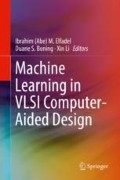Abstract
In this chapter, we propose a new technique, referred to as virtual probe (VP), to efficiently measure, characterize, and monitor spatially correlated inter-die and/or intra-die variations in nanoscale manufacturing process. VP exploits recent breakthroughs in compressed sensing to accurately predict spatial variations from an exceptionally small set of measurement data, thereby reducing the cost of silicon characterization. By exploring the underlying sparse pattern in spatial frequency domain, VP achieves substantially lower sampling frequency than the well-known Nyquist rate. In addition, VP is formulated as a linear programming problem and, therefore, can be solved both robustly and efficiently. Our industrial measurement data demonstrate the superior accuracy of VP over several traditional methods including two-dimensional interpolation, Kriging prediction, and k-LSE estimation.
Access this chapter
Tax calculation will be finalised at checkout
Purchases are for personal use only
References
S. Nassif, Delay variability: sources, impacts and trends, in IEEE International Solid-State Circuits Conference (2000), pp. 368–369
Semiconductor Industry Associate, 2007 International Technology Roadmap for Semiconductors (ITRS) (Semiconductor Industry Association, Washington, 2007)
H. Chang, S. Sapatnekar, Statistical timing analysis under spatial correlations. IEEE Trans. Comput. Aided Des. Integr. Circuits Syst. 24(9), 1467–1482 (2005)
C. Visweswariah, K. Ravindran, K. Kalafala, S. Walker, S. Narayan, First-order incremental block-based statistical timing analysis, in Design Automation Conference (2004), pp. 331–336
Y. Zhan, A. Strojwas, X. Li, L. Pileggi, D. Newmark, M. Sharma, Correlation aware statistical timing analysis with non-Gaussian delay distributions, in Design Automation Conference (2005), pp. 77–82
K. Heloue, F. Najm, Statistical timing analysis with two-sided constraints, in International Conference on Computer-Aided Design (2005), pp. 829–836
M. Mani, A. Singh, M. Orshansky, Joint design-time and post-silicon minimization of parametric yield loss using adjustable robust optimization, in International Conference on Computer-Aided Design (2006), pp. 19–26
S. Kulkarni, D. Sylvester, D. Blaauw, A statistical framework for post-silicon tuning through body bias clustering, in International Conference on Computer-Aided Design (2006), pp. 39–46
Q. Liu, S. Sapatnekar, Synthesizing a representative critical path for post-silicon delay prediction, in IEEE International Symposium on Physical Design (2009), pp. 183–190
M. Ketchen, M. Bhushan, D. Pearson, High speed test structures for in-line process monitoring and model calibration, in IEEE International Conference on Microelectronic Test Structures (2005), pp. 33–38
M. Bhushan, A. Gattiker, M. Ketchen, K. Das, Ring oscillators for CMOS process tuning and variability control. IEEE Trans. Semicond. Manuf. 19(1), 10–18 (2006)
W. Mann, F. Taber, P. Seitzer, J. Broz, The leading edge of production wafer probe test technology, in IEEE International Test Conference (2004), pp. 1168–1195
F. Koushanfar, P. Boufounos, D. Shamsi, Post-silicon timing characterization by compressed sensing, in International Conference on Computer-Aided Design (2008), pp. 185–189
S. Reda, S. Nassif, Analyzing the impact of process variations on parametric measurements: novel models and applications, in Design, Automation & Test in Europe (2009), pp. 375–380
M. Bushnell, V. Agrawal, Essentials of Electronic Testing for Digital, Memory and Mixed-Signal VLSI Circuits (Kluwer Academic Publishers, Norwell, 2000)
A. Oppenheim, Signals and Systems (Prentice Hall, Upper Saddle River, 1996)
R. Gonzalez, R. Woods, Digital Image Processing (Prentice Hall, Upper Saddle River, 2007)
D. Donoho, Compressed sensing. IEEE Trans. Inf. Theory 52(4), 1289–1306 (2006)
E. Candes, Compressive sampling, in International Congress of Mathematicians (2006)
J. Tropp, S. Wright, Computational methods for sparse solution of linear inverse problems. Proc. IEEE 98(6), 948–958 (2010)
D. Donoho, J. Tanner, Precise undersampling theorems. Proc. IEEE 98(6), 913–924 (2010)
C. Bishop, Pattern Recognition and Machine Learning (Prentice Hall, Upper Saddle River, 2007)
W. Press, S. Teukolsky, W. Vetterling, B. Flannery, Numerical Recipes: The Art of Scientific Computing (Cambridge University Press, Cambridge, 2007)
F. Liu, A general framework for spatial correlation modeling in VLSI design, in Design Automation Conference (2007), pp. 817–822
A. Nowroz, R. Cochran, S. Reda, Thermal monitoring of real processors: techniques for sensor allocation and full characterization, in Design Automation Conference (2010), pp. 56–61
R. Tibshirani, Regression shrinkage and selection via the Lasso. J. R. Stat. Soc. 58(1), 267–288 (1996)
G. Golub, C. Loan, Matrix Computations (Johns Hopkins University Press, Baltimore, 1996)
S. Boyd, L. Vandenberghe, Convex Optimization (Cambridge University Press, Cambridge, 2004)
S. Kim, K. Koh, M. Lustig, S. Boyd, D. Gorinevsky, An interior-point method for large-scale l 1-regularized least squares. IEEE J. Sel. Top. Sign. Proces. 1(4), 606–617 (2007)
M. McKay, R. Beckman, W. Conover, A comparison of three methods for selecting values of input variables in the analysis of output from computer code. Technometrics 42(1), 55–61 (1979)
X. Li, R. Rutenbar, R. Blanton, Virtual probe: a statistically optimal framework for minimum-cost silicon characterization of nanoscale integrated circuits, in International Conference on Computer-Aided Design (2009), pp. 433–440
Author information
Authors and Affiliations
Corresponding authors
Editor information
Editors and Affiliations
Rights and permissions
Copyright information
© 2019 Springer Nature Switzerland AG
About this chapter
Cite this chapter
Tao, J. et al. (2019). Efficient Process Variation Characterization by Virtual Probe. In: Elfadel, I., Boning, D., Li, X. (eds) Machine Learning in VLSI Computer-Aided Design. Springer, Cham. https://doi.org/10.1007/978-3-030-04666-8_7
Download citation
DOI: https://doi.org/10.1007/978-3-030-04666-8_7
Published:
Publisher Name: Springer, Cham
Print ISBN: 978-3-030-04665-1
Online ISBN: 978-3-030-04666-8
eBook Packages: EngineeringEngineering (R0)

